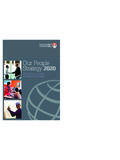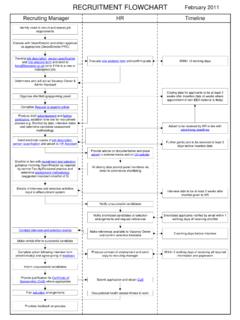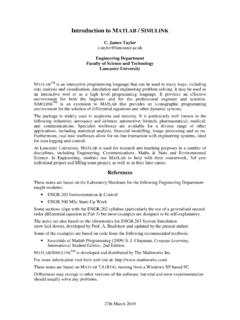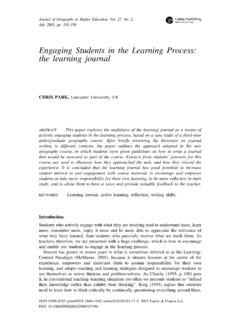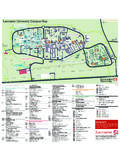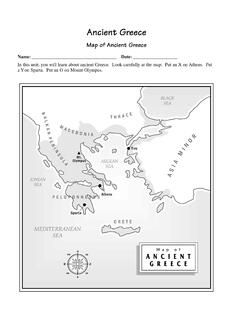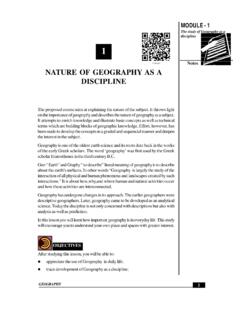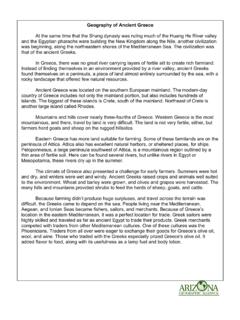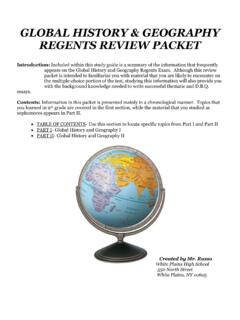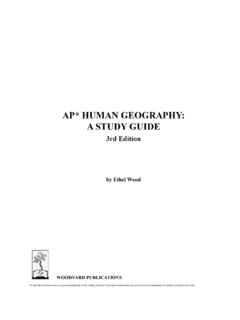Transcription of RELIGION AND GEOGRAPHY - Lancaster University
1 Park, C. (2004) RELIGION and GEOGRAPHY . Chapter 17 in Hinnells, J. (ed) Routledge Companion to the Study of RELIGION . London: Routledge 1 RELIGION AND GEOGRAPHY Chris Park Lancaster University INTRODUCTION At first sight RELIGION and GEOGRAPHY have little in common with one another. Most people interested in the study of RELIGION have little interest in the study of GEOGRAPHY , and vice versa. So why include this chapter? The main reason is that some of the many interesting questions about how RELIGION develops, spreads and impacts on people's lives are rooted in geographical factors (what happens where), and they can be studied from a geographical perspective. That few geographers have seized this challenge is puzzling, but it should not detract us from exploring some of the important themes. The central focus of this chapter is on space, place and location - where things happen, and why they happen there.
2 The choice of what material to include and what to leave out, given the space available, is not an easy one. It has been guided mainly by the decision to illustrate the types of studies geographers have engaged in, particularly those which look at spatial patterns and distributions of RELIGION , and at how these change through time. The real value of most geographical studies of RELIGION in is describing spatial patterns, partly because these are often interesting in their own right but also because patterns often suggest processes and causes. Definitions It is important, at the outset, to try and define the two main terms we are using - GEOGRAPHY and RELIGION . What do we mean by ' GEOGRAPHY '? Many different definitions have been offered in the past, but it will suit our purpose here to simply define GEOGRAPHY as "the study of space and place, and of movements between places".
3 RELIGION is more difficult to define, and whilst many writers have offered working definitions, no single one captures the full meaning of the word. American cultural geographer Yi Fu Tuan (1976) posed the rhetorical question "What is the meaning of RELIGION ?". He then sought to answer it by reflecting on what people seek in, from or through RELIGION . In his view, "the religious person is one who seeks coherence and meaning in his world, and a religious culture is one that has a clearly structured world view. The religious impulse is to tie things together.. All human beings are religious if RELIGION is broadly defined as the impulse for coherence and meaning. The strength of the impulse varies enormously from culture to culture, and from person to person." (Tuan 1976 ). If it is difficult to agree a simple definition of RELIGION , it is even harder to fit boundaries around its impact on people.
4 As Tyler (1990 ) rightly points out, "many of the major religions of the world have become so inextricably linked with particular racial groups, cultures, political systems and lifestyles, that it is difficult to Park, C. (2004) RELIGION and GEOGRAPHY . Chapter 17 in Hinnells, J. (ed) Routledge Companion to the Study of RELIGION . London: Routledge 2 imagine one without the other. It is hard to imagine Thailand without Buddhism, or India without Hinduism, for example. Christianity has become intricately bound up with the lifestyle of Western culture." In essence, RELIGION is so deeply embedded into the matrix of many societies that it's boundaries are permeable and it's impacts pervasive. Themes RELIGION leaves an imprint on landscape, through culture and lifestyle. Religious structures - such as places of worship, and other sacred sites - dominate many landscapes.
5 Religious traditions - Hindu ritual bathing in the Ganges, for example - leave their mark on the physical appearance of an area. Religious observance - church attendance, and so on - affect the time management, spatial movements and behaviour of believers. Given the many ways in which RELIGION affects people and places, there are many possible themes which could be considered here. After briefly tracing the history of geographical interest in RELIGION , this chapter focuses on two central themes which are both defined in terms of space and place. The first theme is the distribution of RELIGION . This can be approached at various scales, from the global to the local. At the global scale the important questions are "which religions are strongest in different places?" and "why might this be so?". Answers to such questions are often provided by more detailed studies of smaller scale distributions and dynamics.
6 Here the key questions include "how do religious groups and new religions spread across space?", "how do they change through time?", and "what processes might account for observed patterns of change through space and time?". The second central theme of the chapter is sacred places and sacred spaces, and how in turn they influence movements of people. A key questions is "why are some places regarded as sacred and special, and why is everywhere not regarded as sacred?". In many religions people are actively encouraged to visit sacred places, and this gives rise to pilgrimage. The movement of large numbers of pilgrims to and within sacred sites is a special religious dynamic which can have very significant impacts on local economies and environments. This choice of focus on distribution and sacred space allows us to explore some of the interesting work published by geographers of RELIGION .
7 But in adopting this focus we consciously overlook many interesting themes which might have been included had space been available. For example, what is the role of RELIGION in defining culture regions (such as the Mormon Culture Region in Utah, and the Bible Belt in the southern states of the USA)? What role has RELIGION played in shaping particular political landscapes (such as the partition of India in 1947, and the geopolitics of Ireland throughout the 20th century)? How have religious factors been imprinted on the physical landscape (such as the distinctive Amish farming landscapes of North America)? HISTORICAL CONTEXT Park, C. (2004) RELIGION and GEOGRAPHY . Chapter 17 in Hinnells, J. (ed) Routledge Companion to the Study of RELIGION . London: Routledge 3 GEOGRAPHY rarely appears in books on RELIGION , and RELIGION rarely appears in books on GEOGRAPHY .
8 One notable exception is the American college texts which offer a sweeping panorama of world GEOGRAPHY , in which there is often a chapter on the global distribution of the major religions and belief systems. That chapter also often includes world patterns of language, and belief systems and means of expression are considered together as basic indicators of human diversity. Most GEOGRAPHY books have no place for RELIGION , and few human geographers concede how important RELIGION can be in shaping people's beliefs, attitudes and behaviour. RELIGION is also a major factor in culture and politics, yet geographers rarely pay more than passing attention to it. This is partly because of academic territoriality - other disciplines claim the study of RELIGION as their own, and GEOGRAPHY is happy to let them. But it also reflects the march of secularisation through much of the English-speaking world, encouraging many academics to downplay the possible significance of RELIGION as a major influence on the day-to-day existence of many people.
9 Past It was not always this way. Lily Kong, a human geographer, has commented that "concerns linking GEOGRAPHY and cosmology in the mind of the religious person lay at the heart of early GEOGRAPHY , and in that sense a GEOGRAPHY that incorporated religious ideas was evident from the earliest times." (Kong 1990, ). Thus, for example, geographers in ancient greece accounted for the spatial order they observed all around them as the result of cosmological principles. Early Muslim geographers travelled widely and described the known world from an overtly Islamic perspective. Celtic monastic schools in Ireland, between the 6th and 11th centuries, were major seats of learning and the scholarship practised in them was biblical in essence and orientation. During the Middle Ages and Renaissance, magic and cosmology were used in equal measure to explain the spatial layout of things across the Earth's surface.
10 Manfred Buttner's (1979) detailed study of the development of GEOGRAPHY in Germany during and after the Reformation reveal that many GEOGRAPHY books were the work of theologians, and shows how geographers were concerned mainly to describe the spread of Christianity around the world. The 16th and 17th centuries saw the emergence of what some writers have referred to as ecclesiastical GEOGRAPHY , typified perhaps by Nathaniel Carpenter's 1625 book GEOGRAPHY Delineated Forth - a treatise as much on theology as on GEOGRAPHY . Varenius's (1649) Descriptio Regni Iaponia was probably the first major geographical description of the distributions of non-Christian religions, other than the earlier Islamic works. Many scholars believe that the term ' GEOGRAPHY of RELIGION ' was first used by Gottlieb Kasche in 1795, in a book (written and published in German) called Ideas about Religious GEOGRAPHY .
